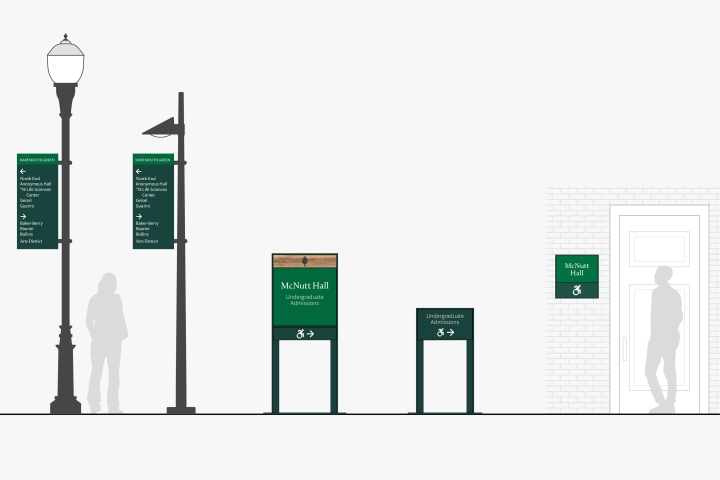Observant pedestrians and motorists may spot temporary signs being set up Wednesday in several areas around campus—the test run of a Dartmouth wayfinding project aimed at clearly marking locations and validating the signs’ scale and legibility.
The wayfinding project, which began this past fall, seeks to increase campus accessibility and answer senior leaders’ call to “make the campus more welcoming,” says Joanna Whitcomb, director of Campus Planning. “This is an incredibly thoughtful and important initiative.”
The project goals include creating a sense of arrival for visitors and helping them find places to park and reach their destination, assisting students and employees in finding their way around campus, and promoting a unified sense of the university.
Planners are reviewing sign designs—colors, fonts, and materials—and potential placement to mark the entrance to Dartmouth from several directions and denote campus buildings, parking lots and garages, sections of campus such as athletics, the Arts District, the North and West ends, admissions offices, and various destinations such as the Bema and the Organic Farm.
Approximately one dozen temporary signs will be placed around campus, photographed, and then taken down, Whitcomb said.
Wayfinding group members are reviewing gateway signs at various entrances to Hanover, vehicular directional signs, parking identification and pedestrian directional signs, and building identification signs. They haven’t yet determined how many signs there will be or their specific placement. The first part of the multi-year project seeks to create signage designs and potential locations. A second phase would have signs made and installed.
After this week’s look at mock-ups in various locations, Whitcomb said a series of fabricated signs will be installed in a section of campus this fall and the wayfinding group will seek feedback on the signs from those on campus and beyond.
The project includes stakeholders from Dartmouth admissions offices, the Arts District, Athletics, Conferences and Events, the graduate and professional schools, student life offices, Transportation Services, Student Accessibility Services, the Office of Communications, and Hanover town officials.
“Clear signage should strike the right balance between readability, being a champion of Dartmouth’s identity, and remaining in the background as a supporting character,” says Laura Varacchi, principal at LVCK, the environmental graphics studio at Beyer Blinder Belle Architects and Planners, the firm working with the campus wayfinding group. “Signage should maintain a quiet voice allowing the beauty of the campus and natural setting to be the showstopper.”


